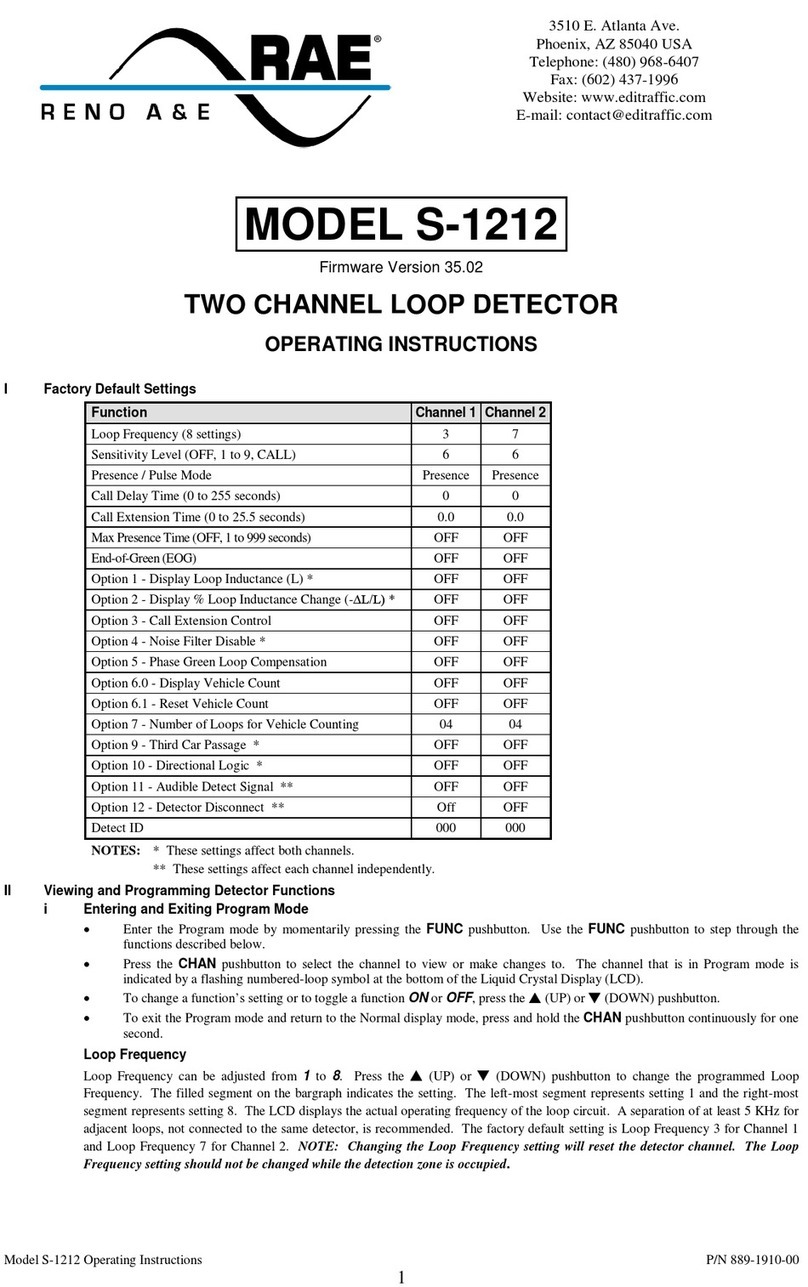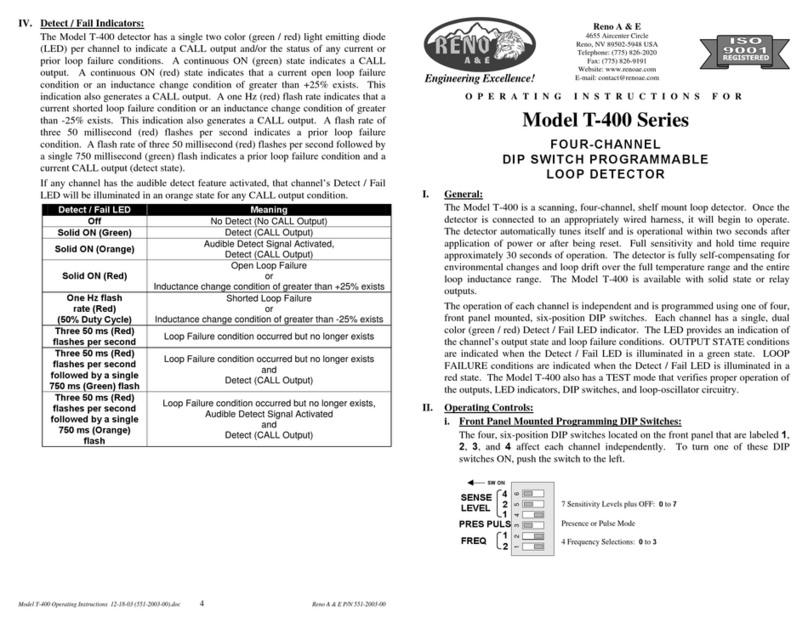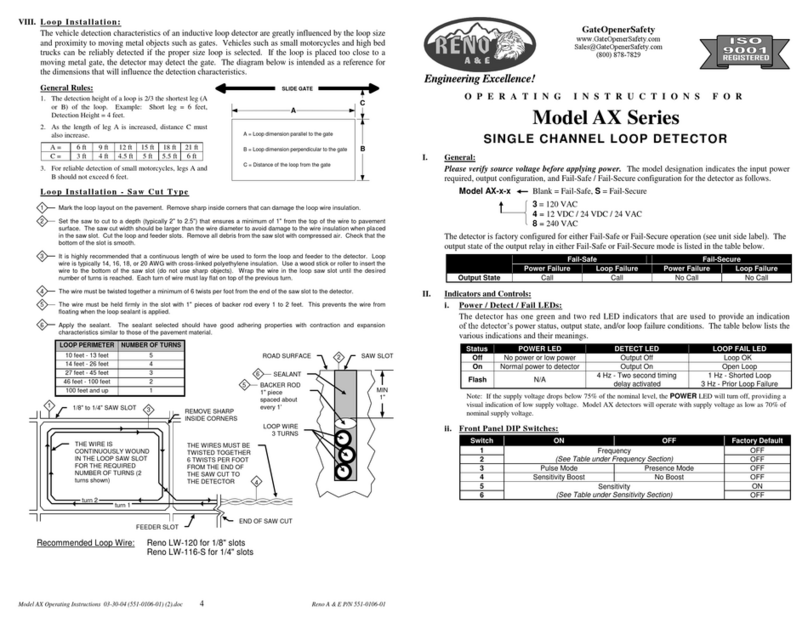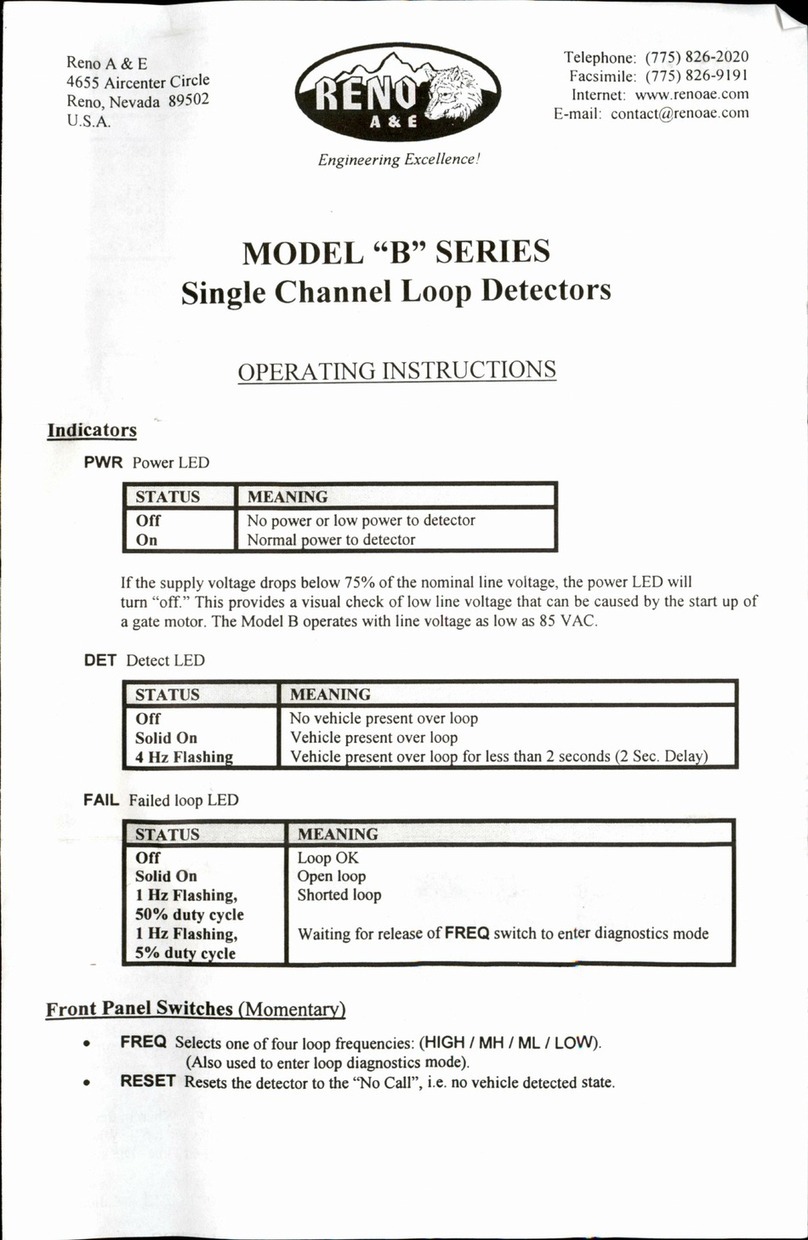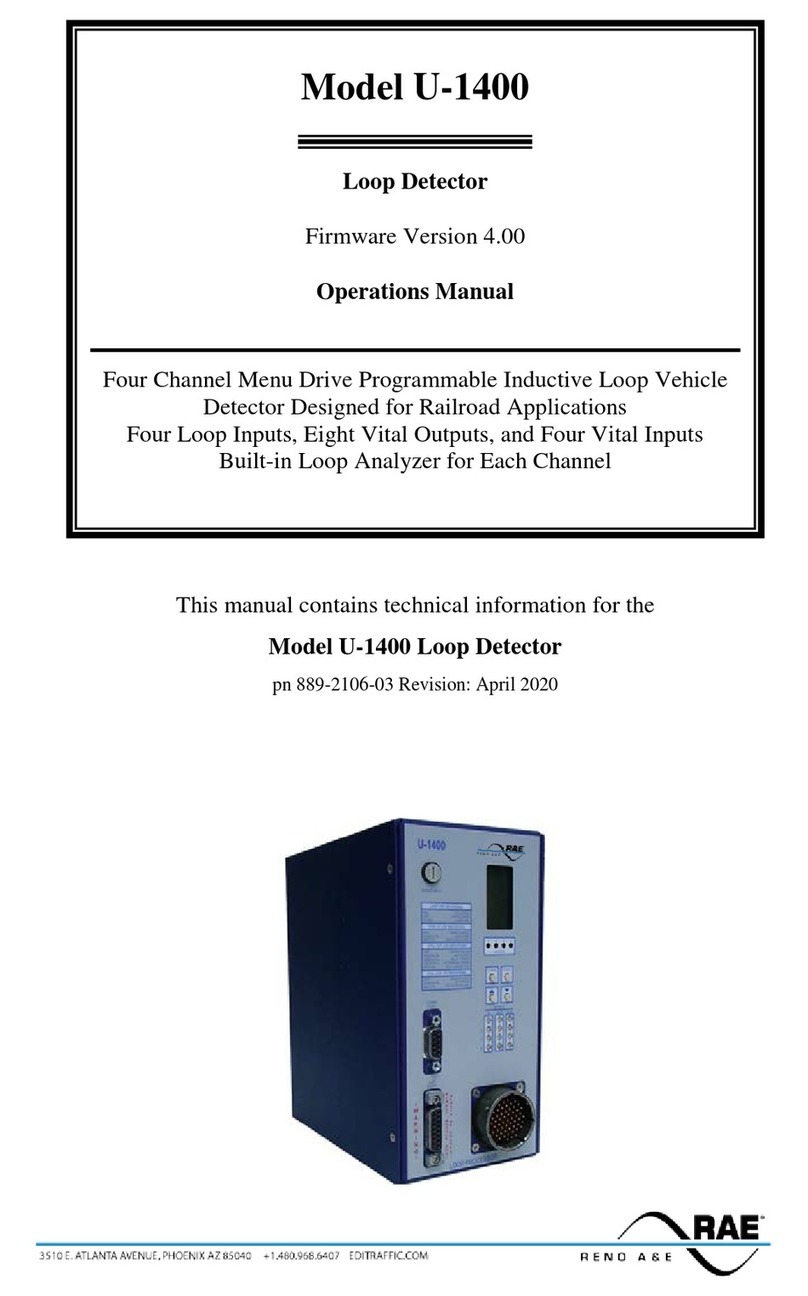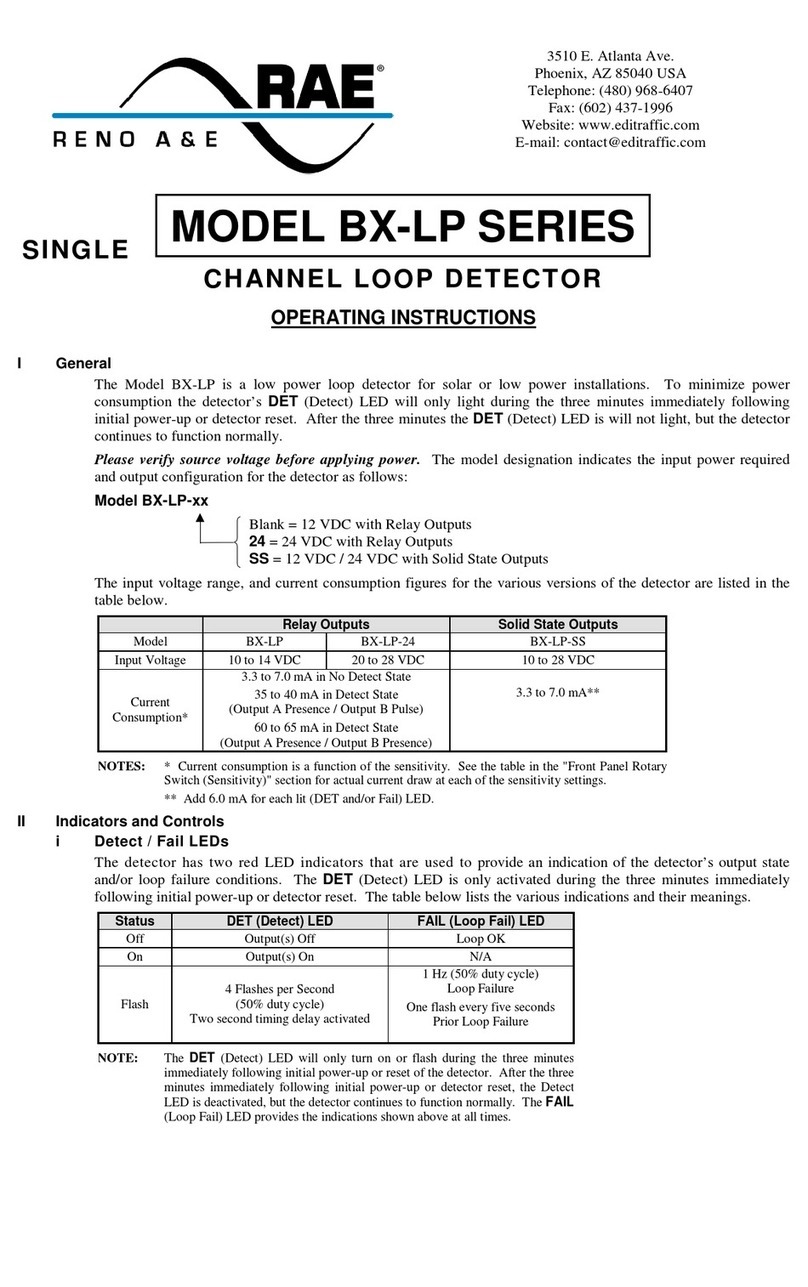
2 3
Front Panel DIP Switches
Switch On Off Factory Default
1 Off
2 See Table under Frequency Section Off
3 Limited Presence True Presence Off
4 Sensitivity Boost No Boost Off
5 2 Second Delay No Delay Off
6 Fail Safe (Output A) Fail Secure (Output A) Off
7 Exit Pulse Entry Pulse Off
8 Presence Mode Pulse Mode Off
Frequency (DIP switches 1 and 2)
Switch Low Med. Low Med. High High
1 On Off On Off
2 On On Off Off
Loop frequency is controlled by DIP switches 1 and 2 on the front panel. Sometimes where
loops are in close proximity, it is necessary to select a different frequency for each loop to
avoid loop interference – commonly known as crosstalk. Four frequencies are available as
shown in the above table. High is the default frequency.
Limited Presence/True Presence (DIP switch 3)
Output A is the presence output. In Presence Mode, the detector has two presence hold times:
Limited Presence and True Presence. Both of these modes output a “Call”, i.e. vehicle
detected, for as long as a vehicle is present in the loop detection area. Limited Presence will
typically hold the Call output for about one to three hours. However, True Presence will hold
the Call for as long as the vehicle is present and power is not removed or reset applied. The
True Presence time applies only for normal size automobiles and trucks and for normal size
loops (approx. 12 ft2– 120 ft2).
Sensitivity Boost (DIP Switch 4)
DIP switch 4 can be turned ON to increase sensitivity only during the detect period without
changing the sensitivity of a vacant loop. When a vehicle enters the loop, the detector then
automatically boosts the loop sensitivity but only during the detect condition. As soon as no
vehicle is detected, the detector immediately returns to the original sensitivity level. This
feature helps prevent dropouts during the passage of high-bed vehicles and is particularly
useful in sliding gate situations.
Output Delay (DIP Switch 5)
A 2 second delay of outputs A and B can be activated by setting DIP switch 5 to the ON
position. Output delay is the time the detector output is delayed after a vehicle first enters the
loop detection area. If the 2 second Output Delay feature is activated, the output relays will
only be turned on after 2 seconds has passed with a vehicle continuously present in the loop
detection area. If a vehicle leaves the loop detection area during the 2 second delay interval,
detection is aborted and the next vehicle to enter the loop detection area will initiate a new full
2 second delay interval. By flashing the front panel DET LED at 4 Hz with a 50% duty cycle,
the detector indicates that a vehicle is being detected but that the output is being delayed.
Fail Safe/Fail Secure (DIP switch 6)
When in the ON position, the detector will operate in Fail Safe mode during a loop fault. If a
loop failure occurs while Fail Safe is activated, Output A activates. When in the OFF position,
the detector will operate in Fail Secure mode during a loop fault. If a loop failure occurs while
Fail Secure is activated, Output A DOES NOT activate. Factory default is Fail Secure.
Entry Pulse/Exit Pulse (DIP switch 7)
In Pulse Mode (with DIP switch 8 set to OFF), the detector can be programmed to output a 250
millisecond pulse only upon vehicle entry over the loop or only upon vehicle exit from the loop.
DIP switch 7 has no effect on output A (the presence output).
Presence/Pulse (DIP Switch 8)
Relay B has 2 modes of operation: Presence and Pulse. When in Pulse mode (DIP switch 8 set
to OFF), the 250 ms pulse can be set for entry pulse or exit pulse via DIP switch 7. When in
Presence mode, the presence hold time is the same as Output A.
III. Reset
Changing any DIP switch position (except 1 or 2) will reset the detector. After changing the
frequency selection switches, the detector will require a reset (a reset will clear the loop fault
memory).
IV. Failed Loop Diagnostics
The FAIL LED indicates whether or not the loop is currently within tolerance. If out of
tolerance, the LED indicates whether the loop failed (1 flash per second) or had an intermittent
loop failure (1 flash every 5 seconds).
V. Pin Connections (Harness Model 802-4)
Pin Color Relay Solid State
1 Black DC + DC +
2 White DC - DC -
3 Orange Relay B, Normally Open Output B, Open Drain
4 Green No Connection No Connection
5 Yellow Relay A, Common DC –
6 Blue Relay A, Normally Open Output A, Open Drain
7 Gray Loop Loop
8 Brown Loop Loop
9 Red Relay B, Common DC -
10 Violet or White/Black Relay A, Normally Closed No Connection
11 White/Green or White/Red Relay B, Normally Closed No Connection
Note: All contacts shown above are with power applied, loops connected, and no vehicle
present. Output B always operates in Fail Secure mode when loop or power fails.
VI. Warnings
Separately for each loop, a twisted pair should be created consisting of only two (2) loop wires
all the way from the loop to the detector (including through all wiring harnesses) at
approximately six (6) full twists per foot. For trouble free operation, it is highly recommended
that all connections (including crimped connectors) be soldered.






